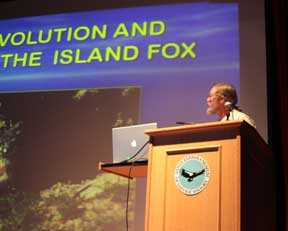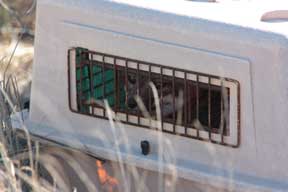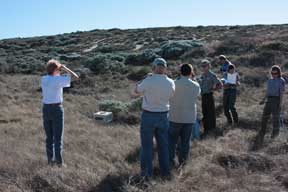Are you looking for information on the origin of island foxes; how they evolved and their biology? Perhaps you’ve heard people question whether golden eagles were actually preying on island foxes. Answer your questions with information from the primary sources.
Friends of the Island Fox is honored to make information available from top researchers and biologists working with the island fox and the Channel Island ecosystem.
 Paul W. Collins, Curator of Vertebrate Zoology at the Santa Barbara Museum of Natural History recently gave two presentations from his accumulated research at an Island Fox Workshop sponsored by the Santa Barbara Museum, Ty Warner Sea Center, Santa Barbara Zoo and Friends of the Island Fox. Both of these presentations are now available through links from the Friends of the Island Fox Educational Research Library.
Paul W. Collins, Curator of Vertebrate Zoology at the Santa Barbara Museum of Natural History recently gave two presentations from his accumulated research at an Island Fox Workshop sponsored by the Santa Barbara Museum, Ty Warner Sea Center, Santa Barbara Zoo and Friends of the Island Fox. Both of these presentations are now available through links from the Friends of the Island Fox Educational Research Library.
- Origin, Evolution and Biology of the Island Fox - looks at genetic, morphological, and archeological data regarding island fox origins and the basics of island fox biology, size, behavior, reproduction and diet
- Diet of Bald and Golden Eagles on the Channel Islands - looks at the role eagles played in the decline of island foxes on the Northern Channel Islands and compares the diet of bald and golden eagles on the islands by examining prey remains in nests.
These two slideshow presentations can be found in the Educational Research Library
Under: “Island Fox Fact Sheets & Current Research”
Under: “Links to Research Sources”
Friends of the Island Fox is endeavoring to create the Internet’s most current library of information regarding island foxes. If you are a researcher or biologist and would like us to link to or host your published work relating to the island fox or the Channel Island ecosystem, please contact the Friends of the Island Fox Webmaster at islandfoxnews@gmail.com
Friday November 7, the remaining able-bodied male island fox in captivity at the captive breeding facility on Santa Rosa Island was released into the wild. This happy day marks an important milestone in the recovery of this endangered species.
You can WATCH a moment of history as 6-year-old, M-67 steps out of his transport carrier and into the island scrub of Santa Rosa Island in Channel Islands National Park. LOOK for M-67's radio telemetry collar. The tracking collar was funded by donations to Friends of the Island Fox and will help keep track of this tiny fox as he makes his way in the wild.
 The door of the travel kennel opened and M- 67 leapt out. But rather than dash off across the lupine studded hillside, he hesitated and looked around. He seemed to know it was a moment to be savored.When island fox populations on the northern islands plummeted to the edge of extinction in 1999, Channel Islands National Park and the Nature Conservancy established captive breeding facilities on San Miguel, Santa Rosa and Santa Cruz Islands “as insurance against the loss of foxes from golden eagle predation.” But as the Channel Island National Park stated in their press release regarding the historic events of November 2008 - “With fox recovery on the rise, the one remaining captive breeding facility on Santa Rosa Island will close. Captive breeding is responsible for saving the island fox from the brink of extinction on Santa Cruz, San Miguel, and Santa Rosa Islands.”
The door of the travel kennel opened and M- 67 leapt out. But rather than dash off across the lupine studded hillside, he hesitated and looked around. He seemed to know it was a moment to be savored.When island fox populations on the northern islands plummeted to the edge of extinction in 1999, Channel Islands National Park and the Nature Conservancy established captive breeding facilities on San Miguel, Santa Rosa and Santa Cruz Islands “as insurance against the loss of foxes from golden eagle predation.” But as the Channel Island National Park stated in their press release regarding the historic events of November 2008 - “With fox recovery on the rise, the one remaining captive breeding facility on Santa Rosa Island will close. Captive breeding is responsible for saving the island fox from the brink of extinction on Santa Cruz, San Miguel, and Santa Rosa Islands.” In the past few weeks, 31 island foxes from the Santa Rosa Island breeding facility have been returned to the wild. Today–November 7, 2008–as Pat Meyer and Friends of the Island Fox, Inc. board members and members of the press looked on, National Park Service biologist Tim Coonan opened the door to freedom for M67. The little 6 year-old male fox was born in the captive breeding facility and over the years had been paired with several females. Now, he sat gazing at the wide open expanse around him.Eight years ago when the Santa Rosa island fox population teetered on the edge of extinction with just 15 remaining individuals, Tim Coonan would have never believed this day could come so quickly. On this perfect autumn day, his words to M67 were prophetic, “Go on, you can do it.”
In the past few weeks, 31 island foxes from the Santa Rosa Island breeding facility have been returned to the wild. Today–November 7, 2008–as Pat Meyer and Friends of the Island Fox, Inc. board members and members of the press looked on, National Park Service biologist Tim Coonan opened the door to freedom for M67. The little 6 year-old male fox was born in the captive breeding facility and over the years had been paired with several females. Now, he sat gazing at the wide open expanse around him.Eight years ago when the Santa Rosa island fox population teetered on the edge of extinction with just 15 remaining individuals, Tim Coonan would have never believed this day could come so quickly. On this perfect autumn day, his words to M67 were prophetic, “Go on, you can do it.”
After a quick look over his shoulder, the little island fox bounded off through the low bushes. As he disappeared over a small hill, we heard the hardy beep, beep, beep of the signal from his radio tracking collar. This historic little fox has returned to the wild wearing a radio collar funded by donations to Friends of the Island Fox.  On this momentous day, Friends of the Island Fox proudly presented funds to Channel Islands National Park for two additional fox radio collars. To date, with your support, Friends of the Island Fox has helped put radio tracking collars on 22 island foxes on the northern islands and 10 island foxes on Santa Catalina Island. Radio tracking collars are vital to monitoring the continued success of one of America’s rarest mammals.For more on the historic return of island foxes to the wild:Coverage by Lance Orozco from KCLU NPR Radio News in Ventura. Link to KCLU Radio
On this momentous day, Friends of the Island Fox proudly presented funds to Channel Islands National Park for two additional fox radio collars. To date, with your support, Friends of the Island Fox has helped put radio tracking collars on 22 island foxes on the northern islands and 10 island foxes on Santa Catalina Island. Radio tracking collars are vital to monitoring the continued success of one of America’s rarest mammals.For more on the historic return of island foxes to the wild:Coverage by Lance Orozco from KCLU NPR Radio News in Ventura. Link to KCLU Radio
Article by Chuck Graham in the Ventura County Reporter, 11/13/08
NBC Nightly News during the week of 11/10-14/08We will be posting video and a podcast of M67’s release in the next week.




